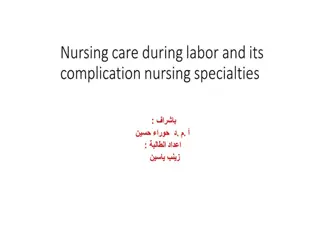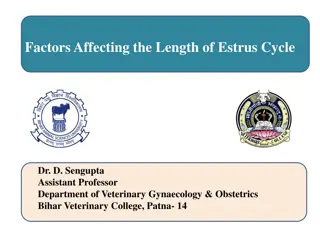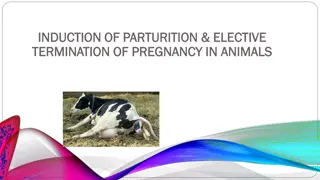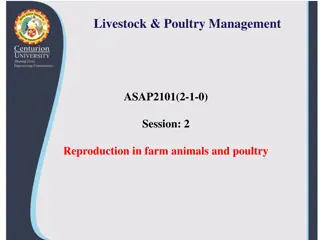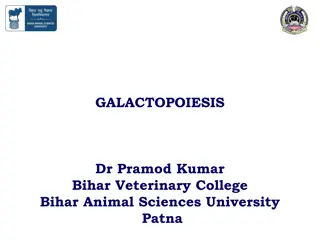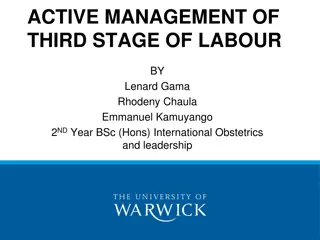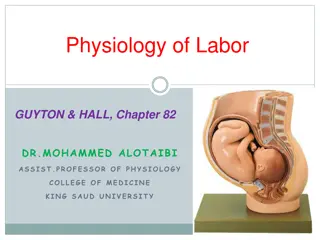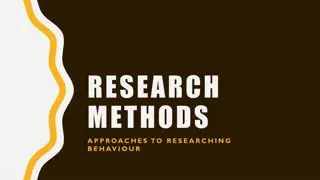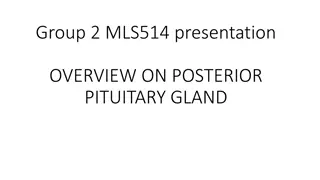Understanding Common Labor Complications and Management Options
Labor and birth processes are typically straightforward, but complications can arise, such as failure to progress, fetal distress, excessive bleeding, malposition, prolapsed umbilical cord, cephalopelvic disproportion, and uterine rupture. Management strategies include rupturing membranes, pain reli
1 views • 24 slides
Understanding Factors Influencing Estrus Cycle Length in Veterinary Science
Factors affecting the length of estrus cycle in animals, such as luteolysis, endocrine control, release of PGF2, and hormonal regulation, play crucial roles in determining the cyclicity and fertility of female animals. This comprehensive study delves into the intricate mechanisms involved in estrus
0 views • 17 slides
Understanding Induction of Parturition in Animals
Explore the process of inducing and terminating parturition in animals, including the hormonal changes associated with pregnancy, fetal nutritional demands, and indications for induction. Learn about the role of oxytocin, adrenal changes in fetuses, and various methods used for inducing parturition.
0 views • 28 slides
Understanding Reproduction in Livestock and Poultry Management
This course delves into the intricate processes of reproduction in farm animals and poultry, covering stages like proestrus, estrus, metestrus, diestrus, and anestrus. It explores the roles of hormones like testosterone, estrogen, progesterone, relaxin, and oxytocin in regulating reproductive functi
0 views • 51 slides
Understanding Galactopoiesis and Milk Ejection in Veterinary Science
Galactopoiesis is the process of maintaining lactation in animals, involving hormones like prolactin, GH, cortisol, PTH, insulin, and oxytocin. This process also includes the role of progesterone, estrogen, and other hormones in milk production and release. Milk ejection, facilitated by oxytocin, in
0 views • 5 slides
Active Management of Third Stage of Labour - Components and Procedures
This session focuses on understanding the active management of the third stage of labour. It covers essential components like early clamping and cutting of the cord, the use of oxytocin, and controlled cord traction. By the end of the session, participants should have a good grasp of these key pract
1 views • 8 slides
Understanding the Microscopic Structure and Function of the Pituitary Gland
Explore the detailed histology of the pituitary gland, focusing on its adenohypophysis and neurohypophysis components. Learn about the diverse parenchymal cells, including acidophils, basophils, and chromophobes, and their respective functions in hormone production. Dive into the significance of the
0 views • 6 slides
The Dark Reality of Milk Industry Adulteration in Kolkata
A shocking exposé reveals the grave dangers lurking in Kolkata's milk industry - cows injected with illegal drugs, contaminated feed and water, and mafia operations. Milk available in the market is tainted with fatal adulterants like oxytocin, antibiotics, and growth hormones, posing serious health
0 views • 26 slides
Understanding Hormones and their Role in the Body
Hormones are chemical messengers that play a crucial role in regulating various metabolic functions in the body. They are transported through the bloodstream to tissues and organs, affecting processes like growth, metabolism, and reproduction. Some hormones have autocrine and paracrine effects in ad
0 views • 25 slides
Wednesday, 18 September 2024 - Kindness and Its Impact on Well-Being
Explore the power of kindness in boosting well-being, happiness, and positivity. Understand how acts of kindness benefit both recipients and givers, fostering a ripple effect of positivity and improved mental health. Discover the science behind kindness, including the release of oxytocin and seroton
0 views • 8 slides
Understanding the Physiology of Labor in Pregnancy
Labor, also known as parturition, is the process of uterine contractions leading to the expulsion of the fetus. Various hormonal changes, including increased estrogen levels, play a crucial role in triggering and regulating labor. The progression from a quiescent uterus to active contractions involv
0 views • 29 slides
Physiology of Labor: Onset and Key Hormonal Changes
Labor, or parturition, involves uterine contractions leading to the fetus's expulsion. Factors triggering labor include hormonal changes like increased estrogen and decreased progesterone, which stimulate uterine muscle activity. Telocytes play a role in spontaneous uterine activity, while oxytocin
0 views • 36 slides
Understanding Research Methods and Approaches in Behavior Studies
Explore various research methods and approaches to studying behavior, including biological, cognitive, and socio-cultural perspectives. Learn about legitimate research methods, assessment criteria, and specific examples such as bio methods focusing on brain, hormones, genes, and behavior. Dive into
0 views • 28 slides
Understanding the Posterior Pituitary Gland and Its Hormones
The posterior pituitary gland, a key part of the endocrine system, plays a vital role in hormone secretion. It controls the release of oxytocin and vasopressin, influencing social bonding, reproduction, and childbirth. Learn about the anatomy, function, and disorders associated with this important g
0 views • 26 slides
Mechanisms Underlying Language Acquisition and Group Belonging
Will Forsyth's review explores how in-group affiliation behaviors facilitate speech acquisition through sociocultural, social-psychological, and social cognition approaches. Neural adaptations in Homo sapiens since Australopithecus, particularly in speech-related areas, are crucial for language evol
0 views • 8 slides
